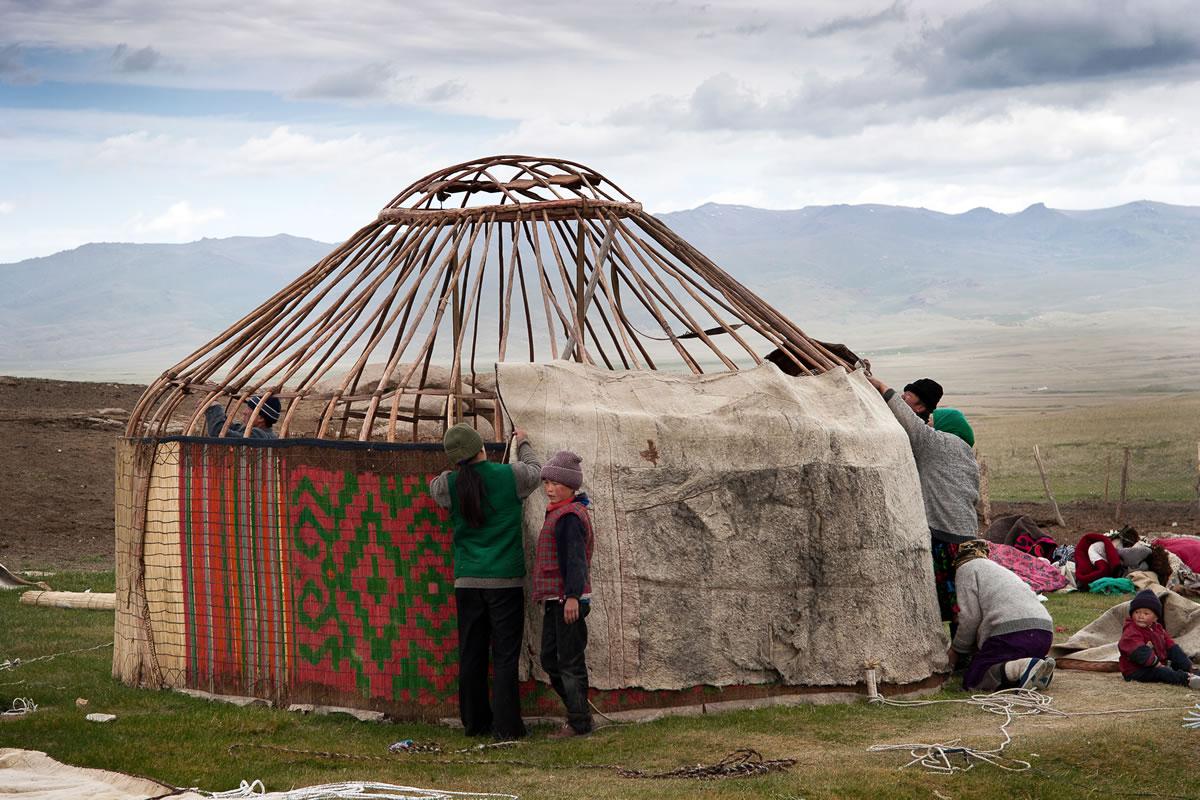
Kyrgyz Yurts: A Legacy of Nomadic Ingenuity
The Kyrgyz yurt, or "boz üy," is an emblem of the nomadic cultures that have traversed the rugged terrains of Central Asia for centuries. These portable homes, ingeniously designed to withstand both the harsh winters and the scorching summers of Kyrgyzstan, are not just shelters but a living symbol of the Kyrgyz people's adaptability and artistic heritage.
Detailed Construction: Mastering the Art of the Yurt
The construction of a Kyrgyz yurt is a marvel of nomadic engineering, blending functionality with aesthetic beauty. The structure begins with the kerege, a collapsible trellis wall that forms the circular base of the yurt. This lattice is made from willow or birch, woods chosen for their durability and flexibility. The uuk, or roof poles, are then connected to the kerege and converge at the tunduk, the crown-like center that serves both as a smoke hole and a skylight.
The entire frame is covered with layers of felt made from the wool of local sheep, meticulously compressed and sewn together. This felt is not only a superb insulator but also customizable, with families often embroidering or painting the exterior with ornate designs that signify their tribal identity and history. The final touch is the bosogo, a felt door that hangs at the entrance, beautifully adorned with traditional patterns.
The Heart of Nomadic Life
The yurt is the centerpiece of Kyrgyz family life, designed to be quickly dismantled, transported, and rebuilt as the nomadic tribes moved between their summer and winter pastures. This mobility was essential for the pastoral lifestyle, allowing families to follow their herds of sheep, horses, and yaks to fresh grazing lands. Inside the yurt, the space is communal and highly organized according to social customs. The right side (when entering) is traditionally reserved for women, where cooking and daily activities take place, while the left side is for men, where weapons and harnesses are kept.
Socially, the yurt plays a pivotal role in community gatherings, celebrations, and decision-making processes. It is a place where old stories are told, songs are sung, and the continuity of the Kyrgyz culture is assured. The layout of the yurt itself is symbolic, with the circular shape representing the eternal sky and the unity of life and nature.
Understanding the Yurt
Construction Insights: Building a yurt is a communal effort, involving the skilled hands of multiple craftsmen. The process begins with the assembly of the kerege (wooden frame), followed by the placement of the uuk (roof poles) that converge at the tunduk.
Historical Legacy: The design of the yurt has evolved over centuries, influenced by the migratory patterns of Central Asian nomads. Its resilience and adaptability to various environmental conditions highlight its evolutionary success.
Contemporary Use: In an effort to preserve this traditional dwelling, Kyrgyzstan has seen a revival of yurt-based tourism, which supports local artisans and provides an eco-friendly lodging alternative.
The Yurt's Modern Relevance: Eco-Tourism and Cultural Preservation
In recent years, the Kyrgyz yurt has seen a resurgence as a symbol of cultural pride and an asset in the eco-tourism sector. Visitors to Kyrgyzstan can stay in yurts scattered across the country’s vast landscapes, experiencing firsthand the traditional nomadic lifestyle while contributing to the local economy. These stays often include traditional meals, horseback riding, and the opportunity to participate in the daily life of a nomadic family, offering a deep dive into the cultural fabric of Kyrgyzstan.
The Kyrgyz yurt is not merely a place of residence; it is a symbol of the enduring spirit of the Kyrgyz people. It embodies the harmony between functionality and beauty, standing as a testament to a lifestyle that has mastered the art of mobility and sustainability. For those seeking an authentic connection to Central Asian culture, a night in a Kyrgyz yurt is an unforgettable experience, bridging the past with the present in the heart of the majestic Kyrgyz landscapes.

